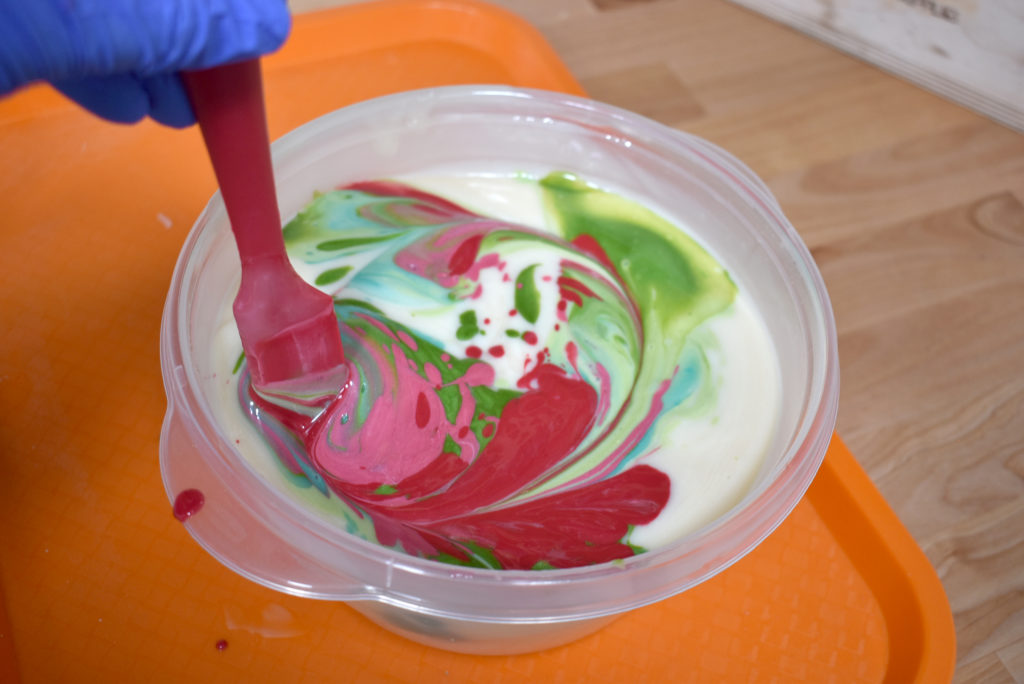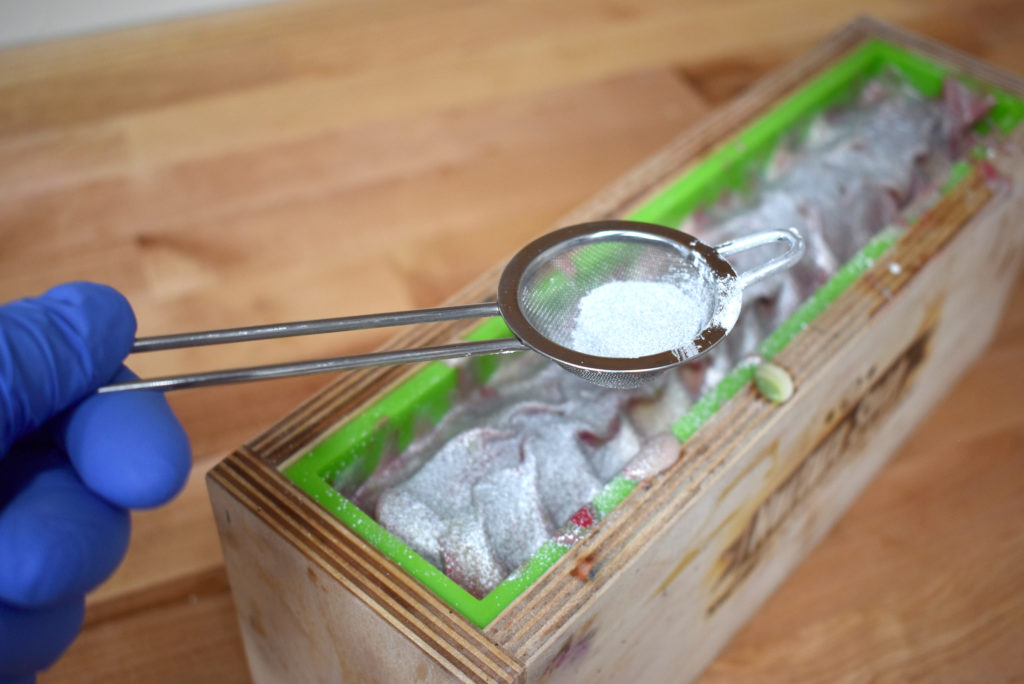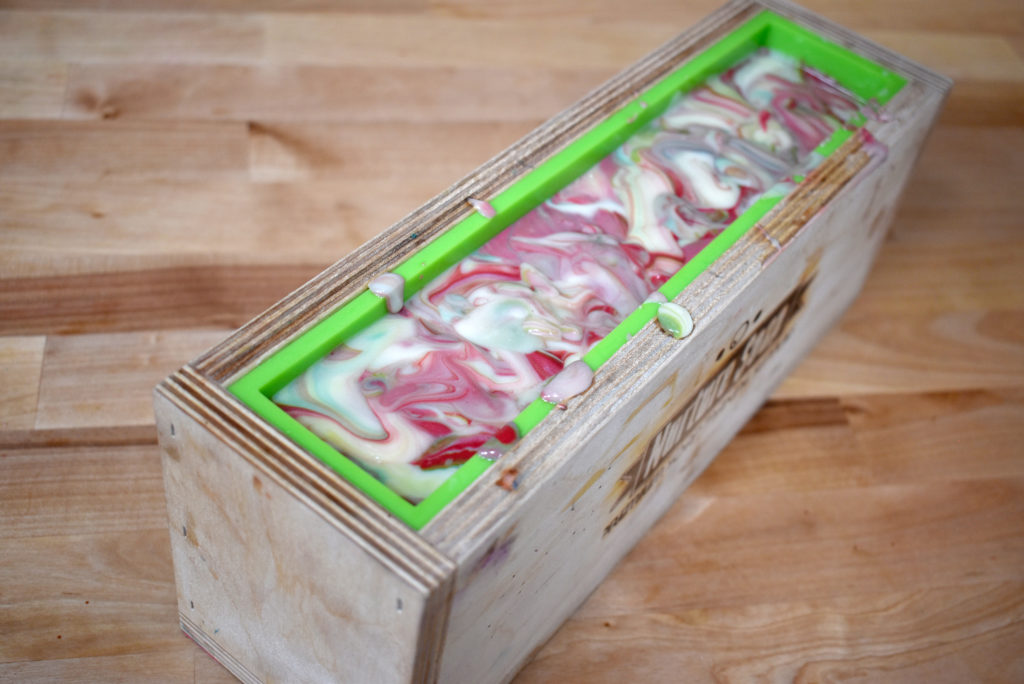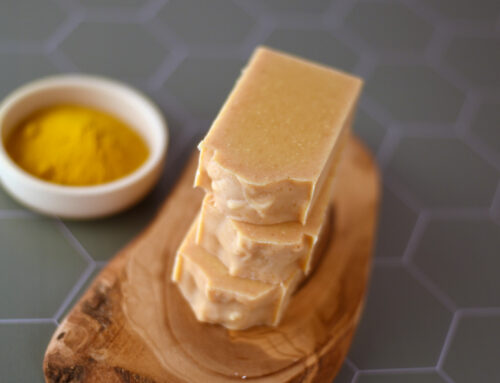In this tutorial, I’m going to show you how to make this in-the-pot swirl and we’re topping it with bio-glitter! If you haven’t heard of bio glitter, here’s what it is!
(Disclosure: Some of the links below are affiliate links, meaning, at no additional cost to you, I will earn a commission if you click through and make a purchase.)

Good Glitter biodegradable glitter biodegrades naturally in waste water! It is an eco-friendly alternative to plastic glitters and is cosmetic approved! Its made of eucalyptus cellulose, and actually becomes food for the same hungry organisms that break down waste products. How cool is that!? You can get your sparkle on and not worry about it being bad for the ecosystem once washed down the drain.
The Good Glitter was nice enough to provide the Lovin Soap community with a coupon code for 10% off! Use coupon code LOVINSOAP when checking out. 🙂

Let’s make soap! I’m going to do an in-the-pot swirl.
I used a Silicone Loaf Mold from Nurture!
Watermelon In-The-Pot Swirl Cold Process Soap Design
Basic Body Bar – More Moisture from Lovin Soap Studio Recipe eBook (Grab your copy for 50 cold process soap recipes + 64 essential oils blends!)
Base Oils
- Coconut Oil (76 degree) – 270 grams (30%)
- Shea Butter – 90 grams (10%)
- Olive Oil – 342 grams (38%)
- Avocado Oil – 72 grams (8%)
- Rice Bran Oil – 126 grams (14%)
Lye Solution
- Sodium Hydroxide – 126 grams (5% superfat)
- Water – 252 grams (1:2, lye:water ratio)
Scent
Use your favorite slow-moving fragrance or essential oil blend. I simply used a blend of lavender and litsea essential oils. If you’re looking for a good place to get essential oils, I HIGHLY recommend Appalachian Valley Natural Products. I love their products and their shipping is super fast!
- Lavender Essential Oil – 15 grams
- Litsea Essential Oil – 15 grams
Colors
- Trial by Fire (Nurture)
- Winter White (Nurture)
- Lime Appeal (Nurture)
- Emerald Green (Nurture)
- Watermelon Sugar Bio Glitter
Let’s make soap! If you are new to soapmaking, be sure to download our free guide, How to Make Cold Process Soap! Gear up in your gloves and your safety glasses.
Step 1: Create a lye solution. Weigh the water and lye into two separate containers. Slowly pour the sodium hydroxide into the water while stirring. Stir until completely dissolved and set aside to cool.
Step 2: Prepare the base oils. First, weigh any solid oils and butters into a container and melt. You can melt using the microwave or low heat on a burner. Next, weigh each liquid oil into the melted oils. The liquid oils will cool down the melted oils and leave you with a base oil mixture that is about at the correct temperature to make soap. It might still need to cool down a bit.
Step 3: Weigh your slow-moving essential oil or fragrance oil into a glass or stainless steel container and add to your base oil.
Step 4: Prepare your mold. If you need to line your mold, line it.
Step 5: Check the temperatures. You should now have a container containing liquid base oils and a container containing lye solution. Take the temperatures using an infra-red temperature gun. Be sure to stir each mixture before taking the temp. You want your temperatures to be between 80-100 degrees F.

Step 6: Once you have reached desired temperatures, pour the lye solution into the oil mixture and mix to emulsion.

Step 7: Once emulsified, divide your soap. I poured into 5 cups but left most of the soap uncolored.
Step 8: Add your colorants and mix. I added each mica to a cup then added red + white and green + white for a little more variance. I added Winter White to my base.

Step 9: Pour each color back into your soap base. I poured in three spots as shown. Rotate through your colors until all are added to your pot. Be sure to watch the video below to see what I mean!
Step 10: Using a spatula and swirl the soap one time. Don’t overdo it or you’ll muddy your soap.

Step 11: Pour the soap into you mold. As you pour, the soap will swirl together.

Step 12: I ended up waiting for about 5 minutes so my soap could thicken. Then I used a spatula to create some texture.
Step 13: I dusted with a white/shimmer mica because I wanted the glitter to pop on top.

Step 14: Top with glitter!

Step 15: Allow your soap to saponify and harden for at least 24 hours. After 24 hours, you can unmold and cut. Cure your soap for 4-6 weeks.
Thanks for reading!
Grab our new eCourse, Swirling Success!
Learn to control trace, so it doesn’t control you!
This detailed video training explores the difference between emulsion and trace, so you know when to stop mixing your soap, allowing enough time to color and execute intricate designs. You’ll leave the eClass with a greater understanding of how water/liquid, temperatures, base oils, fragrance oils, essential oils and additives all affect the movement of your soap to trace.














I am desperate to learn the cold process soap making. Where do I start ? Please help ? So much websites and info I am lost. Please help me start with a tutorial or study or anything 🙏🙏🙏